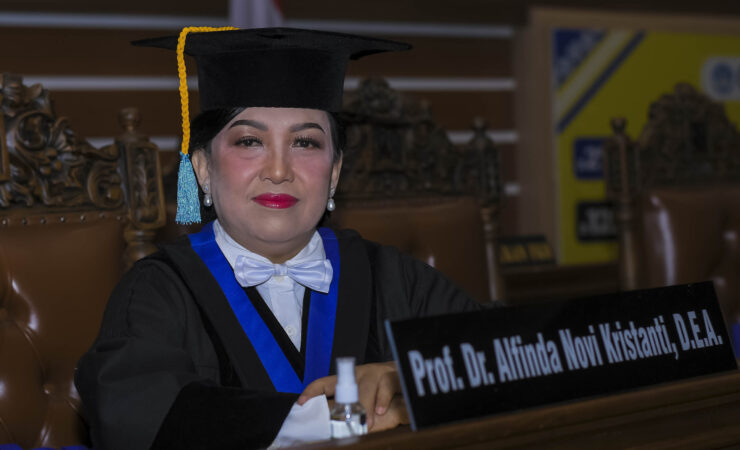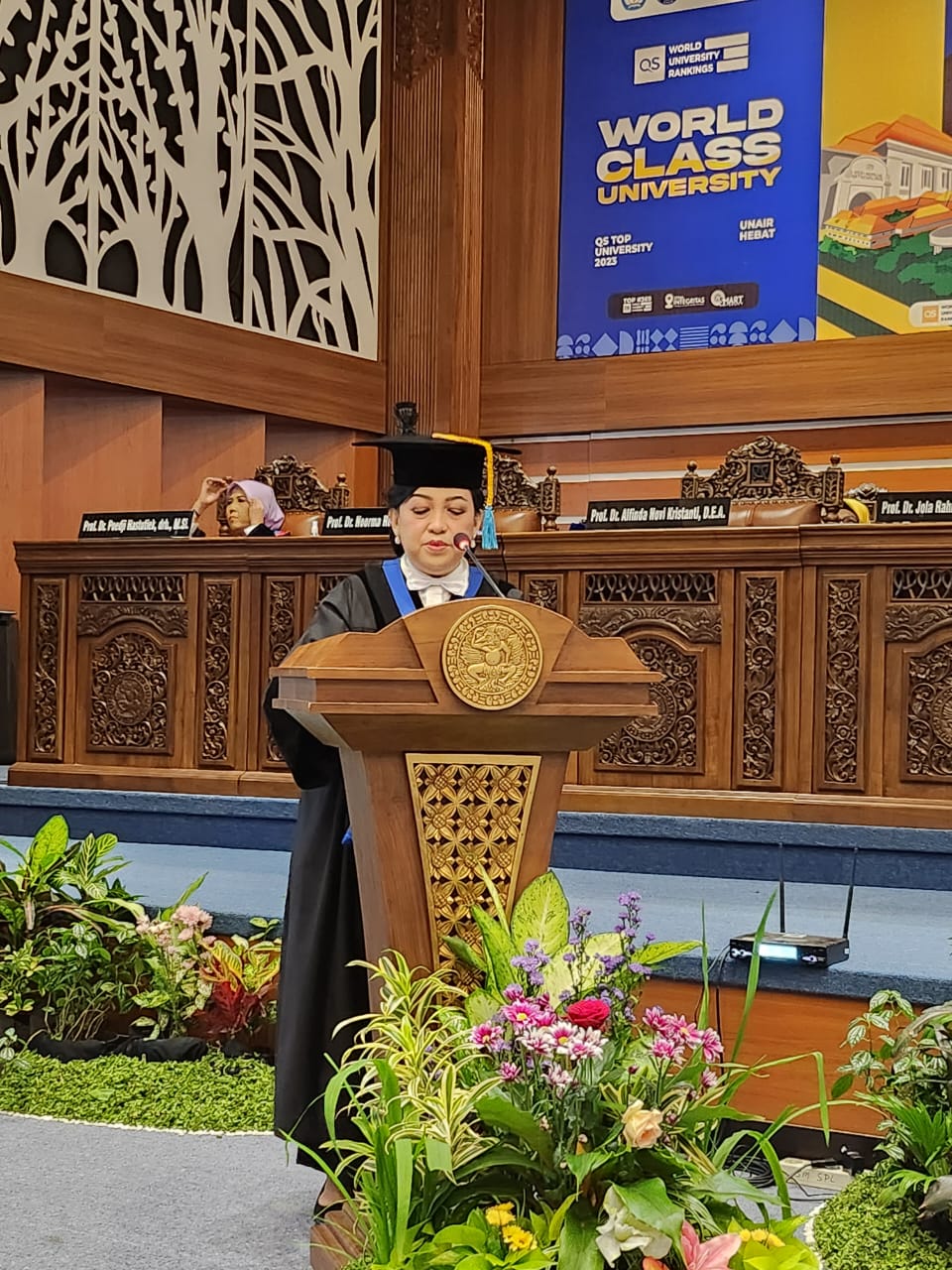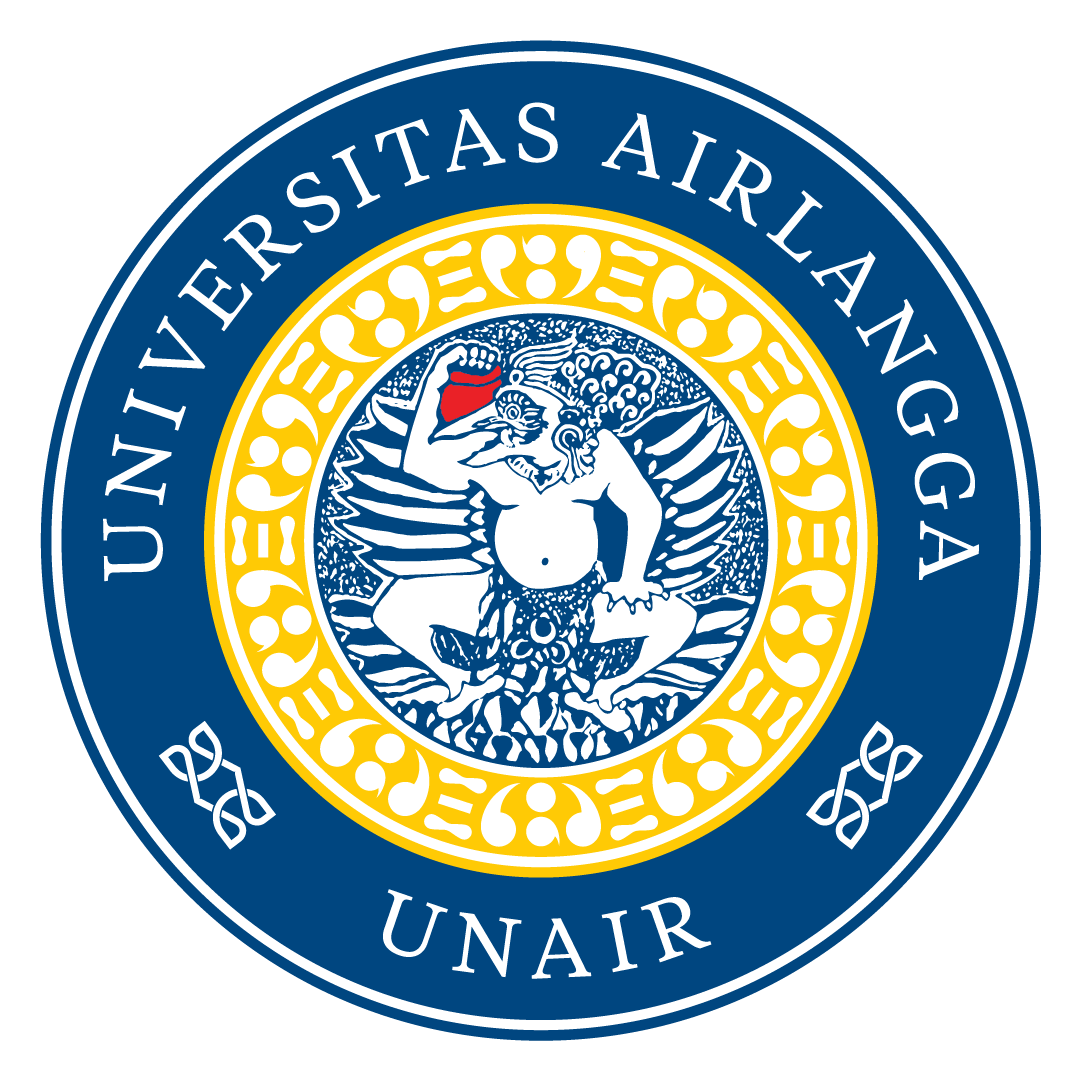Prof. Alfinda Novi Kristanti Officially Inaugurated as Professor of Chemistry at FST UNAIR in the Field of Phytochemistry of Phenolic Compounds

On Thursday, March 2, 2023, Prof. Alfinda Novi Kristanti was officially inaugurated by the Rector of Universitas Airlangga as a professor in the field of Phytochemistry of Phenolic Compounds. In her inaugural speech titled “Phytochemical Study of Phenolic Compounds of Indigenous Indonesian Plants as a Source of Potential Raw Materials for Medicines,” Prof. Alfinda explained that plants can communicate both with each other and with other living organisms and their growing environment. In response to this communication, plants produce toxic compounds to deter predators, colors, and scents that attract insects to aid in their reproduction, and chemical compounds that help them survive adverse environmental conditions. Through these processes, thousands of secondary metabolites with diverse structures and various bioactivities beneficial to humans have been identified.

Often, plants provide compounds with extraordinary potential in very small quantities. From this reality, the field of organic synthesis has rapidly developed in an effort to provide potential compounds in large quantities. Another effort is the development of plant tissue culture techniques that aim to provide potential plant materials in large and uniform quantities in a relatively short time. Recently, the use of nanotechnology to further enhance the potential of plant materials has also grown significantly. Our research group has focused on medicinal plants and endemic plants of Indonesia. The results of research on Aquilaria microcarpa (agarwood), Uncaria gambir (gambier), and Gynura procumbens (longevity spinach) will be presented in this speech.
Trees of the Aquilaria species produce fragrant resinous wood known as agarwood. The fragrant agarwood resin is known for use in perfumes and other fragrances. Research findings show that Aquilaria is rich in chromone content. The discovery of chromone brings to mind the 2-styrylchromone compound group, which is rarely found in nature. As of 2016, only nine derivatives of 2-styrylchromone had been isolated from natural sources, despite this group of compounds being known for their diverse bioactivities. Due to their rarity in nature, their availability must be ensured through organic synthesis in the laboratory.
Synthesis with several variations of benzaldehyde structures yielded nine 2-styrylchromone compounds. Further in silico studies using docking experiments with proteins often used as potential drug targets for cancer chemotherapy development were conducted. The compound with three methoxy groups on the benzene ring was the most active among the synthesized compounds. This finding aligns with another researcher’s statement that the compound exhibits high cytotoxic activity against several human cell lines. Subsequently, three different types of 2-styrylchromone derivatives were synthesized. Molecular dynamics simulation results showed that the synthesized compounds have promising potential as inhibitors. This series of studies is an example of how nature provides the structural ideas for synthesizing compounds with better potential activity and the possibility of producing them in large quantities.
Hot water extracts from the leaves and twigs of the Uncaria gambir plant that are precipitated, molded, and dried produce gambier. Gambier is one of Indonesia’s high-value plantation commodities. Indonesia controls 80% of the world’s major export markets. The main component of gambier is catechin. Isolation results showed that the catechin content in gambier is 1.8% (1 kg of gambier contains 18 g of catechin) with a purity level of 90%. Catechin can act as an anticancer, antiviral, antimicrobial, and its antioxidant activity is much greater than vitamin C. Derivatization was performed to enhance the bioactivity and bioavailability of catechin, where all derivatives showed better anticancer activity against cervical cancer cells than catechin in vitro.
Additionally, nanotechnology is another effort to enhance the bioactivity and bioavailability of gambier extracts. Research findings indicate that nano-encapsulation can increase anticancer activity against cervical and breast cancer cells in vitro and reduce the toxicity of gambier extracts. Nano-gambier extract also demonstrated improved chemopreventive activity against breast cancer in mice induced with benzo[α]pyrene in vivo. Histological analysis of breast tissue showed significant differences, indicating the potential of gambier in nanoparticle form. Rich in catechin, gambier acts as an exogenous antioxidant that reduces reactive oxygen species (ROS). Catechin can also induce endogenous antioxidant levels, indirectly preventing potential cancer occurrence.
The leaves of Gynura procumbens (longevity spinach) have been widely used for various treatments due to their diverse bioactivities, thanks to the various secondary metabolites they contain. The roots of this plant have not been extensively reported, but one researcher compared the bioactivity of the leaves and roots, finding that the roots are much more active than the leaves. However, using the plant roots means uprooting the entire plant, which takes time to regrow.
Research in our group focuses on increasing biomass and secondary metabolite content using adventitious root culture of the plant. The main objective of this continuous research is to provide raw medicinal materials from the plant roots consistently and uniformly. Efforts to develop the potential of this plant also utilize nanotechnology. Research has shown that nanoparticle forms of plant extracts can enhance anti-dengue activity while reducing extract toxicity.
This content was re-uploaded from the website Kajian Fitokimia Senyawa Fenolik Tanaman Asli Indonesia sebagai Sumber Bahan Baku Obat Potensial • Metro Times News

